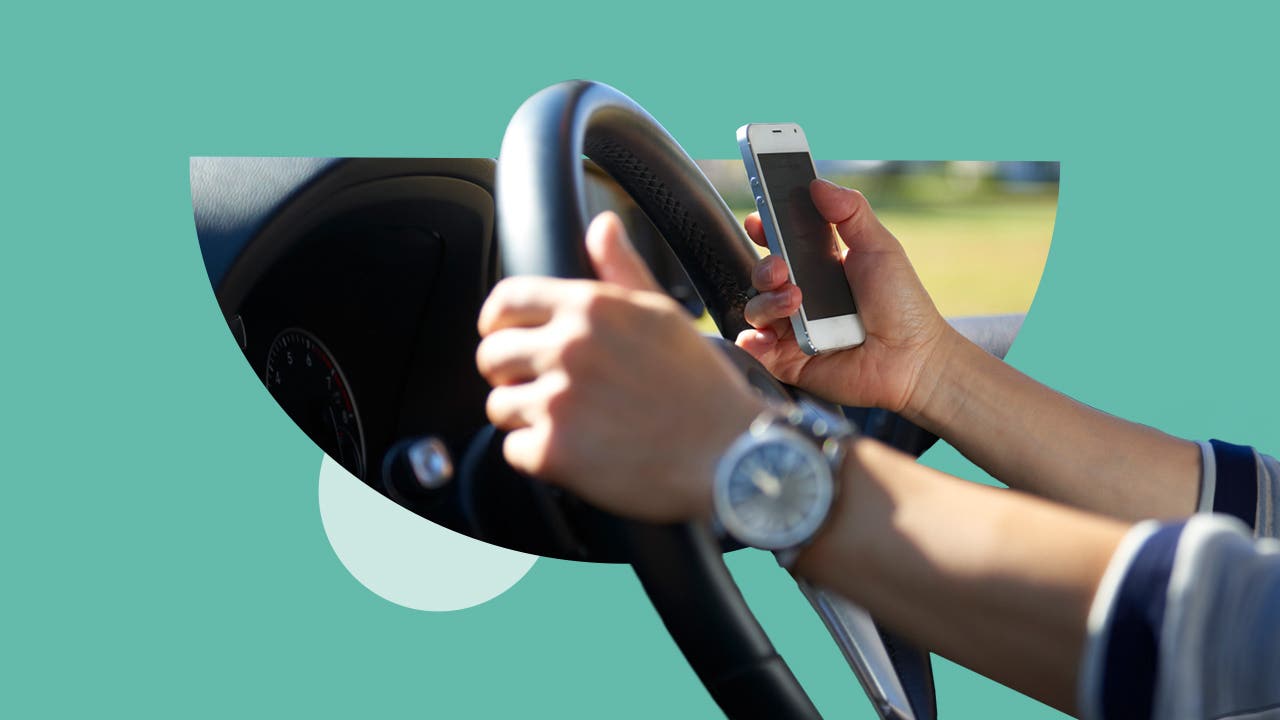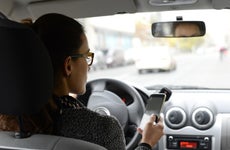Texting and driving statistics 2024

The Bankrate promise
At Bankrate, we strive to help you make smarter financial decisions. To help readers understand how insurance affects their finances, we have licensed insurance professionals on staff who have spent a combined 47 years in the auto, home and life insurance industries. While we adhere to strict , this post may contain references to products from our partners. Here's an explanation of . Our content is backed by Coverage.com, LLC, a licensed entity (NPN: 19966249). For more information, please see our .
Despite the presence of texting and driving laws in 48 states, the practice remains a significant hazard on American roads. According to the National Highway Traffic Safety Administration (NHTSA), on any given day in 2022, there were notable instances of drivers engaged in cell phone use while driving. This behavior is a key factor in distraction-affected crashes, which accounted for 8 percent of all fatal traffic accidents. Specifically, there were 3,047 fatal traffic crashes involving distractions, leading to 3,308 total fatalities. Among these, cell phone use was identified as the distraction in 368 fatal accidents, highlighting its continued risk despite awareness and regulations.
These statistics are not just numbers but represent lives lost and families affected. They serve as a critical reminder of the importance of focusing solely on driving while behind the wheel. It’s important for drivers to understand the risks and make conscious decisions to avoid distractions, particularly from cell phones and other electronic devices, which could significantly reduce the likelihood of fatal accidents.
- At any moment during the day, more than 800,000 drivers are using a hand-held device. (NCSL)
- 60% of teens 18 and older admit to emailing or texting and driving compared to 16% of 15- and 16-year-olds (CDC)
- Texting while driving has the same effect on your driving reaction time as if you had consumed four beers in a single hour. (Drivesafeonline.org)
- Texting distracts you long enough to travel the length of an entire football with your eyes off the road, driving at 55 mph. (NHTSA)
- 35% of teens admit to texting and driving, even though 94% of them understand the dangers. (AAA)
- 1 in 4 teens admit to responding to at least one text every time they drive. (AAA)
- 10% of parents and 20% of teens admit to having multi-text conversations while driving. (AAA)
- Drivers aged 15 to 20 make up 8% of drivers in fatal traffic crashes but account for 9% of all distracted drivers and 11% of those distracted by cell phones. (NHSTA)
- The 21 to 24 age group, while only 9% of drivers in fatal crashes, represents 10% of all distracted drivers and 12% of those distracted by cell phones. (NHSTA)
- Drivers between 25 to 34 years old are disproportionately represented in distraction-related crashes, comprising 21% of fatal crash drivers but 23% of all distracted drivers and 28% of cell phone-related distractions. (NHSTA)
- In the 35 to 44 age group, these drivers make up 17% of those in fatal crashes but account for 18% of all distracted drivers. (NHSTA)
- The first reduction in distracted driving since 2020 was recorded in 2023, with a 4.5% decrease that helped prevent over 55,000 crashes, 31,000 injuries, 250 fatalities and saved close to $2.2 billion in economic damages in the U.S. (Cambridge Mobile Telematics – CMT)
- A 10% increase in distracted driving is linked to a 1.5% rise in the fatality rate, highlighting the critical impact of distraction on road safety. (CMT)
Texting and driving deaths per year
How many people die from texting and driving per year? About 400 fatal crashes happen each year as a direct result of texting and driving. That number increases to over 30,000 when you consider distracted driving as a whole, according to the NHTSA. While texting and driving accidents are decreasing, overall fatal crashes due to distracted driving are on the rise.
In the most recent available data, you can see that cell phone-related deaths spiked in 2019 and 2021, with the other years hovering around 400 fatalities per year.
| Year | Cell phone in-use fatalities |
|---|---|
| 2018 | 393 |
| 2019 | 430 |
| 2020 | 397 |
| 2021 | 423 |
| 2022 | 402 |
Source: NHTSA
What are the dangers of texting and driving?
The United States Department of Transportation (USDOT) says that it takes about five seconds to read a text. During that time, you drive about the length of a football field at around 55mph, which is 360 feet — quite a long way to have your eyes off the road.
The issue is not just the momentary lapse in attention but also the additional time it takes for your eyes to reorient to the road and the other cars around you. Once a driver uses their phone, it can take up to 27 seconds for the mental distraction to wear off, according to the AAA Foundation. This is known as the “hangover effect.”
Teens and young drivers are especially susceptible to the dangers of texting and driving when they have fewer years of experience under their belt. This inexperience, coupled with a lack of advanced driving skills, can equate to more accidents and, sadly, more fatalities in this age group.
Other drivers are not the only ones that you risk hurting on the road. The NHTSA reports that, in 2022, 681 passengers, 498 pedestrians and 87 bicyclists were all killed by distracted driving. The highest rate of drivers causing a fatal crash who were using a cell phone was 14 percent for anyone falling between the ages of 15 to 34. The lowest incidents were in the 75 and older age group at 4 percent.
The history of texting and driving
Texting capabilities were not introduced until the early 1990s, but it has gradually become a dangerous and even fatal distraction for some. Take a trip down memory lane from the early days of texting to the current trends we see today in nearly every cell phone user.
The 90s
Texting was not very common when it was first introduced in 1993. While capabilities were limited and nothing like what we see today, it was the beginning of a dangerous trend.
In 1997, the first phone equipped with a keyboard was introduced, making texting easier and more “convenient.”
Texting was finally available across all networks in 1999. At the time, phone plans typically came with limited talk time. College kids began taking advantage of the quick and inexpensive option of texting.
There are several reasons why texting has really taken off. It’s a faster method of communication that offers the privacy of a phone call without the same time and attention demand. It’s also cheaper. Cell phone users quickly found that their providers were more generous with text message allotments than they were with minutes. To stay within their plans, subscribers began relying on texting as a primary and more affordable means of communication.
The early 2000s
Texting took off in the early 2000s, with over 250 billion text messages sent worldwide by 2002. In 2007, Americans sent more texts in a month than they made in monthly calls for the first time in history.
That same year, GPS navigation became mainstream, giving drivers another distraction on the road. To program an address, it takes approximately 40 seconds and another 13 seconds to refocus on driving. This makes using a GPS as dangerous or even more so than texting and driving.
Modern day
Texting and driving is still a problem, with 39 percent of high schoolers admitting to texting and driving behind the wheel. Over the years, cell phone use has changed with the sharp increase in social media platforms available.
For instance, TikTok challenges and users posting videos while they’re driving has increased cell phone usage. Of people aged 18-29, 97 percent have a smartphone and their usage of it has increased over time, leading to the highest dependency of all age groups.
Social media usage is widespread, with 4.8 billion users worldwide, which accounts for 59.9 percent of the global population and 92.7 percent of all internet users. From April 2022 to April 2023, social media platforms saw an increase of 150 million new users, a 3.2 percent growth from the previous year. This growth breaks down to about 410,000 new social media users every day, or roughly 4.7 new users every second.
On average, people engage with about 6.6 different social media platforms each month. The typical daily time spent on these platforms totals about 2 hours and 24 minutes. Altogether, these figures add up to a collective 11.5 billion hours spent on social media platforms worldwide every single day.
Safe driving technology
Modern technology is increasing the options for safer communication. Apps like DriveMode sense how fast a person is going, silencing text and phone alerts above 15 mph when a person is assumed to be in a car. Other apps allow drivers to compete against each other for the safest driving habits or earn insurance discounts for reducing their risk on the road through telematics programs.
Most cell phones will now read your texts aloud to you with a simple prompt of “read my text messages,” and most keyboards now offer a voice-to-text tool that allows users to speak their texts instead of typing them. Keep in mind that voice-to-text technology can still distract you from the road.
Risk factors of texting and driving
All age groups are guilty of texting and driving, but data from the NHTSA shows that some groups are far more active than others.
Drivers between the ages of 25 and 34 far exceed the usage of older adults, with the 35-44 and 45-54 age groups also showing greater cell phone use while driving. The risk of texting and driving begins to decrease after 54, showing that drivers ages 55 years and up are more responsible on the road and less likely to end up in a car crash due to texting and driving.
2022 Fatal Crashes by Age Group
| Age Group | Number | % of Drivers Using Cell Phones |
|---|---|---|
| 15-20 | 41 | 11% |
| 21-24 | 44 | 12% |
| 25-34 | 105 | 28% |
| 35-44 | 69 | 18% |
| 45-54 | 55 | 15% |
| 55-64 | 40 | 11% |
| 65-74 | 13 | 3% |
| 75+ | 7 | 2% |
| Total | 375 | 100% |
Source: NHTSA
Teen Behaviors
The 2021 Missouri Youth Risk Behavior Survey, supported by a cooperative agreement between the U.S. Centers for Disease Control and Prevention Division of Adolescent and School Health and the Missouri Department of Elementary and Secondary Education, offers new insights into teenage behaviors on the road. This survey specifically tracks the trends in 2017, 2019 and 2021 regarding high school students who were passengers in cars driven by someone who was texting or emailing while driving.
The data from the survey provides a clear view of the trends in texting and driving among teens. Over these years, there’s been a gradual decline in the percentage of both male and female high school students who reported being in a car with a driver who was texting or emailing. While these figures represent only a small subset of the population, they still highlight a significant concern: texting and driving remains a prevalent issue among teenagers, underscoring the importance of continued educational and preventive measures.
| Reported riding in car while driver was texting or e-mailing | ||
|---|---|---|
| Year | Male % | Female % |
| 2017 | 58.9% | 71.4% |
| 2019 | 57.6% | 70.0% |
| 2021 | 54.0% | 65.4% |
Source: CDC
The consequences of texting and driving
Texting while driving is considered a moving traffic violation. Depending on where you live, texting while driving may also be considered a Class B or Class C criminal misdemeanor.
Currently, almost every state has some kind of law that addresses texting and driving or handheld use. Many states have looked to financial penalties as a reasonable consequence for texting and driving. Penalties range from $20 to $500, depending on the state, but in some states like Alaska, Iowa, Louisiana and Oregon fines can reach as high as $1,000 and mean a misdemeanor offense.
- Points on your driving record
- Suspension of your driver’s license
- Revocation of driving privileges
- Mandatory driver safety courses
- Vehicle impoundment
When bodily injury is involved, offenders of texting and driving may also face jail or prison time. Penalties vary, but commercial drivers and school bus drivers are commonly held to stricter penalties due to the public nature of their positions. Consequences heighten in severity when you have repeated offenses.
Texting and driving laws state by state
Laws vary by state, so it’s crucial to review the specific texting and driving laws that affect your area. This is a comprehensive, state-by-state listing of current U.S. texting and driving laws from the Governors Highway Safety Association (GHSA).
-
State Handheld Ban? All Cell Phone Ban? Text Messaging Ban? Alabama Yes Primarily for 16- or 17-year-olds with intermediate licenses or less than six months with a permanent license. School bus drivers secondary. Yes Alaska No No Yes Arizona Yes School bus drivers (primary), 18 and younger (secondary) Yes Arkansas Primarily school and work zones School bus drivers (primary), 18 and younger (secondary) Yes California Yes School bus drivers (primary), 18 and younger (secondary) Yes Colorado No 18 and younger (primary) Yes Connecticut Yes 18 and younger (primary) Yes Delaware Yes Learner or intermediate license (primary) Yes District of Columbia Yes Learners permit (primary) Yes Florida Primarily school and work zones No Yes Georgia Yes School bus drivers (primary) Yes Guam Yes No Yes Hawaii Yes 18 and younger (primary) Yes Idaho Yes No Yes Illinois Yes School bus drivers and younger than 19 (primary) Yes Indiana Yes 21 and younger (primary) Yes Iowa No Restricted or intermediate license (primary) Yes Kansas No Learner or intermediate license (primary) Yes Kentucky No School bus drivers and younger than 18 (primary) Yes Louisiana Learner or intermediate license and school zones School bus drivers and younger than 18 (primary) Yes Maine Yes Learner or intermediate license (primary) Yes Maryland Yes School bus drivers and younger than 18 (primary) Yes Massachusetts Yes School bus drivers and younger than 19 (primary) Yes Michigan Yes Yes (all) Yes Minnesota Yes School bus drivers and younger than 18 (primary) Yes Mississippi No School bus drivers (primary) Yes Missouri Yes School bus drivers (primary) Yes Montana No No No Nebraska No School bus drivers and younger than 18 (primary) Yes Nevada Yes No Yes New Hampshire Yes 18 and younger (primary) Yes New Jersey Yes School bus drivers and permit or provisional license (primary) Yes New Mexico No Permit or provisional license (primary) Yes New York Yes No Yes North Carolina No School bus drivers and younger than 18 (primary) Yes North Dakota No 18 and younger (primary) Yes Ohio Yes 18 and younger (primary) Yes Oklahoma Learner or intermediate license (primary) School bus drivers primary Yes Oregon Yes 18 and younger (primary) Yes Pennsylvania No No Yes Puerto Rico Yes No Yes Rhode Island Yes School bus drivers and younger than 18 (primary) Yes South Carolina No No Yes South Dakota No Learner or intermediate license (primary) Yes Tennessee Yes School bus drivers and learner or intermediate license (primary) Yes Texas Yes, in school crossing zones and on public school property only School bus drivers with minor passengers and younger than 18 (primary) Yes Utah No School bus drivers and younger than 18 (primary) Yes Vermont Yes Younger than 18 (primary) Yes Virgin Islands Yes No Yes Virginia Yes School bus drivers (primary) Yes Washington Yes Learner or intermediate license (primary) Yes West Virginia Yes Younger than 18 with learner or intermediate license (primary) Yes Wisconsin Yes, in work zones only Learner or intermediate license (primary) Yes Wyoming No No Yes Source: GHSA
How texting and driving impacts car insurance rates
Car insurance rates are all based on risk, calculated for each individual based on a specific set of rate factors that determine how much you pay for your coverage each year. This includes everything from where you live and the kind of car you drive to your credit score (in most states), driving history and claims record.
It’s typically a good idea to shop and compare car insurance quotes each year to find the best car insurance provider for you. Car insurance can get particularly pricey when you have a texting and driving offense on your driving record, so be sure to also consider the cheapest car insurance companies in your state to find a policy that’s affordable for you.
The prevalence of texting and driving has a direct and significant impact on car insurance rates. As highlighted in the Insurance Information Institute’s distracted driving report, “The effects of distracted driving are contributing to the net combined ratio for personal auto – a measure that demonstrates profitability in a particular line of insurance. The industry’s personal auto combined ratio soared past 100 in 2022, primarily due to inflationary loss pressures and the increase in accidents caused by distracted driving.”
This indicates that as accidents related to distracted driving increase, so do the financial risks to insurers. These risks are typically passed on to consumers in the form of higher premiums, especially for those with texting and driving offenses on their records. Therefore, maintaining a clean driving history free from texting offenses not only contributes to safer roads but also helps keep your car insurance costs lower.
How to prevent texting and driving
Governments and organizations can do their best to deter the practice with harsh penalties and required driver education, but the truth is that it is a personal habit that you have to commit to breaking yourself. The easiest and simplest way to prevent texting and driving is to not text and drive.
It’s easier said than done, but these are some tips to help you stop texting and driving when you are behind the wheel.
Be clear about usage
Texting and driving doesn’t just mean sending an errant text while you’re cruising down the road. Instead, it’s become a broad term used to describe a number of different behaviors involving your cell phone. Texting and driving can also refer to emailing, calling or using social media like Facebook, Instagram, Twitter or TikTok.
Develop a pre-driving routine
Check your messages and respond if necessary before driving. If you expect an immediate response, let the recipient know you’re driving now and will get back to them when you are at your destination.
Keep your phone out of reach
You can’t use your phone if you can’t reach it, so put it in the glove box, the backseat or even the trunk so you are not tempted to reach for it while you’re driving.
Prepare your directions
Whether you use your phone’s navigation or your car’s GPS, be sure to prepare and review your directions before you depart. It can be very dangerous to fumble with directions and drive in traffic at the same time, easily leading to an accident. Instead, take a minute to bring up your directions before you leave so you can have a smooth journey ahead.
Use your phone’s features
Today, many phone manufacturers help deter texting and driving by offering a “Do Not Disturb” or DriveMode function. This function sets up a quiet mode, silencing incoming notifications while the feature is enabled. You will still receive messages, but they are held for later review once you’re done driving. You can sometimes enable these settings to send an automated text response to calls or incoming messages that you are driving and will answer later.
Set an example
Don’t text behind the wheel when others are in your vehicle, and refuse to respond to messages when you know a loved one is driving. For parents, this is essential with teen drivers present.
Get involved and educate
Parents have the combined role of both educator and enforcer at home, so it’s critical that parents take an active role in their family’s safety. Be sure to properly educate your children on the dangers of texting behind the wheel, including sharing texting and driving facts and statistics. You can also bring it up in conversation with friends to spread awareness of the risks associated with this activity.
Apps to prevent texting and driving
Some apps are designed specifically to help drivers on the road and potentially reduce texting and driving habits.
| App name | iOS | Android | Description |
|---|---|---|---|
| AT&T DriveMode | ✔ | ✔ | To encourage responsible cell phone use, AT&T offers its DriveMode app for both Android and iOS. This app can detect when you’re in motion, sending an automated reply that you’re driving and will respond later. Bilingual capabilities for both English and Spanish are available, and parents especially love the additional security features, which gives you insight into your child’s usage and whether the app is even enabled. |
| OnMyWay: Drive Safe, Get Paid | ✔ | ✔ | The OnMyWay mobile app offers a unique incentive for drivers to avoid distracted driving by rewarding them with real money and other perks. Users earn rewards simply by keeping their phone locked while driving over 10 MPH. The rewards include cash cards, free gas, gift cards and even travel deals, which are only subject to taxes and fees. So far, OnMyWay claims to have saved over 204 lives and prevented more than 31,319 car crashes, according to their reports. This app could potentially benefit anyone who wants to ensure they stay focused on the road, and it also rewards passengers, making it a beneficial tool for families looking to protect their loved ones. |
| Safe 2 Save | ✔ | ✔ | The Safe 2 Save app is designed to promote safer driving by rewarding users with points for not using their phones while driving. These points can be redeemed for perks at favorite restaurants and local businesses. Users can either manually open the app when they start driving or enable an auto-on feature for convenience. The app supports the use of Bluetooth for music and navigation, allowing drivers to access maps through a specific function without triggering distracting notifications. It also offers a fun element by enabling users to compete with friends and family to see who can accumulate the most points, turning safe driving into a rewarding challenge. |
| LifeSaver | ✔ | ✔ | Sometimes, we don’t even think to check our phones until the flash of a new notification piques our curiosity and we fall victim to temptation. LifeSaver quietly works in the background of your phone, sensing when you are in movement and automatically silencing all incoming notifications. Even if you try to use your phone while you are in motion, all you will receive in response is a locked screen until you are finished driving. In the meantime, you can still receive calls and use your phone as a passenger. |
Bottom Line
Despite the clear dangers, avoiding the temptation to text while driving can be challenging. To help stay focused on the road, consider placing your phone out of easy reach whenever you drive. This simple change can significantly reduce the urge to check notifications. If you rely on your phone for navigation, set your destination and activate ‘Do Not Disturb’ before you start your journey to minimize distractions. Utilizing apps that promote safe driving habits by rewarding you for not using your phone can also be a practical tool. Remember, each decision to avoid distractions while driving contributes not only to your safety but also to the safety of everyone on the road. Making these small adjustments can make a big difference in fostering safer driving environments for all.
Related Articles



